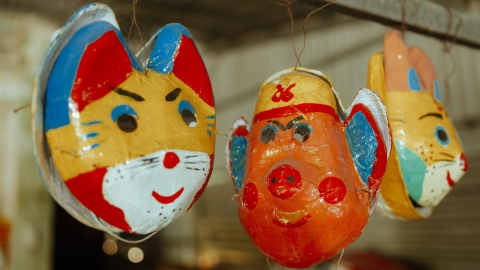From childhood memories to the passion for making lion heads
At 42 years old, Mr. Bang Chi Hung still remembers clearly the lantern parade nights when he was a child. “I used to follow the lion dance troupe in the neighborhood, and I loved it the most when the drums beat rapidly, the whole lion seemed to come to life before my eyes,” he said, smiling as he recalled. It was that passion that led him to the profession of making lion heads, partly to satisfy his hobby, partly to earn more income to support his family.


His Thuan An Company has now become one of the familiar lion head workshops in Saigon. Work here is not only bustling during the Mid-Autumn Festival but also lasts all year round, because nowadays lion dances not only appear during the Lunar New Year but are also associated with opening ceremonies, longevity celebrations, inaugurations and even international competitions. “Customers usually book one to two months in advance. During the Mid-Autumn Festival, orders are slightly higher but not too much, because the workshop is almost fully booked at that time,” he shared.

The lion heads were ordered by a lion and dragon troupe in Hai Phong at Thuan An Factory.
Meticulous in every step
Entering the workshop these days, the smell of paint and paper mixed in the air, the sound of tapping bamboo frames, the sound of paint brushes creating a unique rhythm. The walls are full of lion heads, from those newly framed to those gradually taking shape. “Creating the frame is the most difficult step, because if the frame is a little off, the lion head will no longer have the right shape,” Mr. Hung said.


Workers at the workshop are creating a lion head frame from bamboo and rattan.
Each lion head is the result of a series of manual steps, requiring skill and patience. The main materials are rattan and bamboo, which are dried, split and smoothed to create flexibility and easy bending. Mr. Hung said that creating the frame is the most important stage, determining the shape and durability of the product. After the frame is completed, the craftsman glues each layer of curtain fabric, dries it, then glues another layer to make the frame stronger.



Lion head after gluing fabric to the entire frame
The drawing stage is when the lion is “breathed into life”. Each brushstroke determines whether it is sad, happy or fierce. “The eyes are the hardest part, they must be drawn with soul, so that when the lion dances, the viewer can feel its liveliness. A beautiful lion head must make people want to look at it a second time,” said a young worker in the workshop.


The craftsman uses a brush and paint to draw patterns on the lion's head.
Once the paint is dry, the process of attaching the fur, beard, and tail begins. White sheep wool is chosen to create a soft feel. Beautiful unicorns have bright eyes, long beards, and a majestic appearance. The zipper inside is carefully tied so that the eyes and ears can move when dancing.
On average, each lion head takes 5-7 days to complete, depending on the size and complexity. Small lion heads, in particular, take more time because they require high precision. “We have all kinds of dragons, lions, and unicorns weighing from 2.5 to 6 kg,” Mr. Hung said.

A lion head takes 5 to 7 days to complete.
Five Elements Color Palette and Unique Style
The lion head at Thuan An Company's workshop carries a strong traditional element while still maintaining the five-element color scheme: metal - wood - water - fire - earth. Depending on the purpose, the lion head can be designed brightly with a red or yellow background, white swirl feathers for tournaments, or a more harmonious color scheme for ceremonies.
Lion heads come in different types, such as pointed, curved, and upward-pointing beaks, representing fierce majesty, or round, fist-like beaks, also known as “fist horns,” creating a more gentle feel. In addition to traditional Vietnamese lion styles, the workshop also makes Mengkok lions, a type of lion originating from China, known in Malaysia as Lofochiu, recognizable by their eyes and foreheads with three LED rings, thorny cheeks, and pointed noses, giving off a fierce look. Not only lions, this place also makes dragon heads, phoenixes, and earth god masks for dance troupes across the country.



Mr. Hung's workshop accepts to make all types of lions from traditional Vietnamese to Chinese and Malaysian lion lines.
From small factory to international market
The facility’s products not only serve customers in Ho Chi Minh City but are also sent to Hai Phong, the Central provinces, and exported to France, the US, Malaysia, Singapore, Hong Kong, Thailand, etc. The colorful lion heads have become “ambassadors” of Vietnamese culture in many places around the world.
In the workshop, souvenir flags from international competitions and exchanges are hung solemnly on the wall. Mr. Hung proudly said: “That is a memory of the time when I was directly dancing and exchanging, and also a motivation to continue to maintain the profession.”


Souvenir flags from lion dance competitions that Hung participated in when he was young are hung on the wall of his house.
On the days leading up to the Mid-Autumn Festival, the drums of lion dance troupes resound far into the night, blending with the sound of paint brushes and scissors cutting fabric from Thuan An Hang workshop, creating a bustling work music. From here, the colorful lion heads will follow the lion dance troupes around the streets, bringing joy to children and adults to complete the joy of the moonlit night.




































